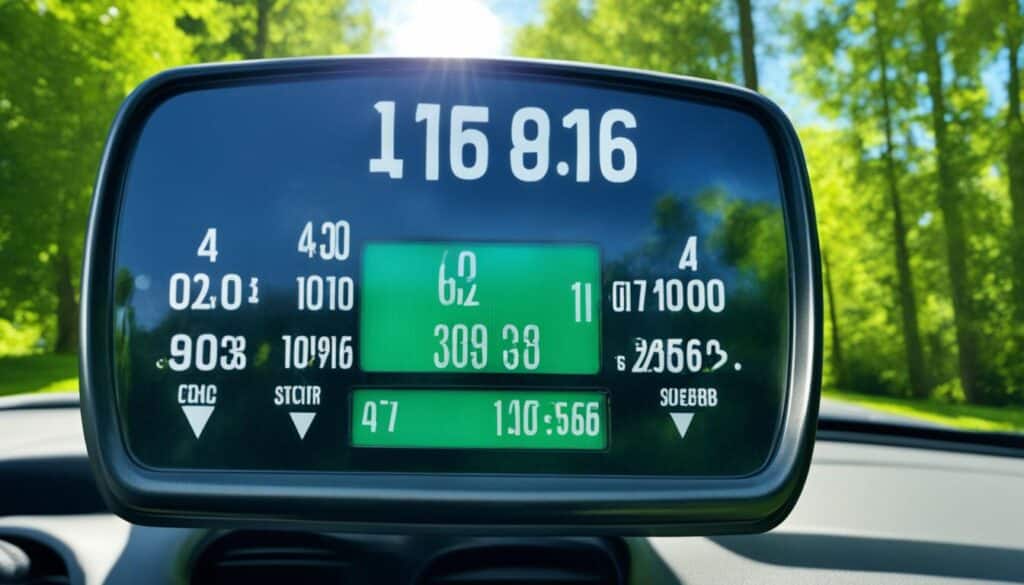When it comes to general insurance, individuals have the power to take specific steps to lower their insurance premiums. By implementing smart strategies and making informed choices, it’s possible to find more affordable coverage. Let’s explore some effective ways individuals can reduce their insurance costs.
Key Takeaways:
- Shopping around and getting multiple quotes from different insurance companies is essential to find the best deal.
- Considering the financial health of the insurance company and consulting consumer magazines for recommendations can help individuals make an informed choice.
- Asking for higher deductibles, reducing coverage on older cars, and bundling homeowners and auto coverage with the same insurer can result in lower insurance costs.
- Maintaining a good credit record, taking advantage of low mileage discounts, and seeking out other discounts can contribute to more affordable general insurance premiums.
Shop Around for the Best Insurance Quotes
When it comes to lowering general insurance premiums, one of the first steps individuals should take is to shop around for the best insurance quotes. Prices for insurance can vary significantly from company to company, so it’s important to gather multiple quotes to ensure a comprehensive comparison.
There are several ways individuals can shop around and obtain insurance quotes. They can directly call insurance companies to inquire about their rates and coverage options. Additionally, accessing information on the internet allows individuals to compare prices and policies from various insurers at their convenience.
State insurance departments can also be valuable resources for comparing prices charged by major insurers. These departments often provide information on the average rates for different coverage types, helping individuals make informed decisions about the affordability and suitability of insurance options.
While price is an important consideration, it should not be the sole determining factor. It’s crucial to evaluate other factors, such as the financial stability of the insurance company and recommendations from friends and family. Consulting consumer magazines and using checklists to compare quotes can further assist individuals in finding the best insurance coverage at the most affordable price.
To illustrate the benefits of shopping around for insurance quotes, consider the following table:
| Insurance Company | Quote 1 | Quote 2 | Quote 3 |
|---|---|---|---|
| Company A | $500 | $550 | $600 |
| Company B | $450 | $500 | $550 |
| Company C | $400 | $450 | $500 |
As shown in the table, by shopping around and gathering quotes from multiple insurance companies, individuals have the opportunity to discover significant differences in pricing. In this example, choosing Company A without exploring other options would result in a higher insurance premium compared to the more affordable options offered by Company B or Company C.
Shopping around for insurance quotes not only helps individuals find the best price but can also provide insight into available coverage options. By dedicating time to research and compare insurance quotes, individuals can make informed decisions based on their budget, coverage needs, and personal circumstances.
Consider the Impact of Vehicle Choice

The choice of vehicle can have a significant impact on general insurance premiums. Before buying a car, individuals should consider several factors that can affect insurance costs.
Car’s Price
The price of the car plays a crucial role in determining insurance costs. Generally, more expensive cars require higher premiums, as the cost to repair or replace them is higher.
Safety Record
The safety record of a car is another important consideration. Cars with a good safety record and features that reduce the risk of injuries are typically eligible for discounts on insurance premiums.
Theft Likelihood
The likelihood of theft is also a factor that can impact insurance rates. Cars with a high risk of being stolen may have higher premiums compared to cars with low theft likelihood.
To make an informed decision when purchasing a car, individuals can refer to the valuable information provided by the Insurance Institute for Highway Safety. They provide detailed safety ratings and insights on different vehicle models, helping individuals choose a car that meets their needs while keeping insurance costs in check.
Adjust Deductibles to Reduce Costs

One effective strategy for lowering general insurance premiums is adjusting deductibles. Deductibles are the amount individuals pay out of pocket before their insurance coverage kicks in. By choosing higher deductibles, individuals can reduce their collision and comprehensive coverage costs, leading to significant cost savings.
For example, increasing the deductible from $200 to $500 can result in cost savings of 15 to 30 percent on insurance premiums. Opting for a higher deductible of $1,000 or more can potentially save individuals 40 percent or more.
However, it’s crucial to ensure that enough money is set aside to cover the deductible in the event of a claim. It’s recommended that individuals have an emergency fund or savings specifically designated for insurance deductibles.
Benefits of Adjusting Deductibles:
- Cost Savings: Higher deductibles can lead to lower insurance premiums, resulting in immediate cost savings.
- Flexibility: Adjusting deductibles allows individuals to customize their insurance coverage to align with their financial needs and risk tolerance.
- Insurance for Catastrophic Events: Lowering premiums through higher deductibles provides individuals with the opportunity to allocate more resources to protect against catastrophic events that may have a higher financial impact.
By carefully considering the financial implications and weighing the potential savings, individuals can make informed decisions when adjusting deductibles to reduce their general insurance costs.
“Choosing higher deductibles can be a cost-effective strategy for lowering insurance premiums and can result in significant savings. However, it’s important for individuals to assess their financial situation and ensure they have sufficient funds in case of a claim.”
Evaluate the Need for Comprehensive Coverage on Older Cars

When it comes to lowering general insurance premiums, it’s important for individuals to evaluate the need for comprehensive coverage on older cars. Comprehensive coverage provides protection against events such as theft, vandalism, and natural disasters. However, it may not always be cost-effective, especially for older cars.
One way to determine if comprehensive coverage is necessary is to consider the value of the car. If the value of the car is less than 10 times the premium for comprehensive coverage, it may not be financially prudent to purchase this additional coverage.
There are resources available that can help individuals assess the value of their cars. Auto dealers, banks, and online platforms like Kelley’s Blue Book can provide a reliable estimation of a car’s worth. By obtaining this information, individuals can make informed decisions and avoid paying for unnecessary coverage.
It’s also important to review insurance coverage at renewal time. As cars age, their value may depreciate, making comprehensive coverage even less cost-effective. By regularly reviewing coverage and aligning it with the value of the car, individuals can optimize their insurance needs and reduce premiums.
Is Comprehensive Coverage Worth It?
While comprehensive coverage provides comprehensive protection, it may not always be a cost-effective option for older cars. By considering the value of the car and reviewing coverage needs, individuals can make informed decisions about whether comprehensive coverage is worth the investment.
Insurance is all about finding the right balance between adequate coverage and cost effectiveness. By evaluating the need for comprehensive coverage on older cars, individuals can lower their general insurance premiums while still maintaining appropriate protection.
| Factors to Consider | Cost Effectiveness |
|---|---|
| Car Value | Less than 10 times comprehensive coverage premium |
| Resources | Auto dealers, banks, Kelley’s Blue Book |
| Review Coverage | At renewal time and align with car value |
Take Advantage of Multi-Policy Discounts

Bundling homeowners and auto coverage with the same insurer can lead to significant savings on general insurance premiums. Many insurance companies offer a multi-policy discount to policyholders who have multiple types of insurance with them. By combining homeowners and auto coverage under one insurer, individuals can enjoy insurance savings while simplifying their insurance management.
When individuals bundle their policies, they only need to deal with one carrier, making it easier to keep track of coverage and payments. This streamlines the insurance process and eliminates the need to juggle multiple insurance providers.
However, it’s crucial to compare prices from different insurance companies to ensure that the overall coverage and value are still the best. While multi-policy discounts can result in savings, it’s important to strike a balance between affordability and comprehensive coverage.
To illustrate the potential benefits of multi-policy discounts, consider the following table:
| Type of Insurance | Annual Premium |
|---|---|
| Homeowners | $1,200 |
| Auto | $1,000 |
| Bundled | $1,800 |
In this scenario, opting for a multi-policy discount by bundling homeowners and auto coverage would result in an annual premium of $1,800, saving $400 compared to purchasing the policies separately.
To take advantage of multi-policy discounts, individuals should contact their insurance provider or use online resources to explore bundle options. By consolidating their insurance needs, individuals can save money while ensuring they have the necessary coverage for their home and vehicle.
Benefits of Multi-Policy Discounts
- Significant savings on general insurance premiums
- Simplification of insurance management
- Streamlined coverage and payment tracking
- Potential for increased customer loyalty and retention
By taking advantage of multi-policy discounts, individuals can enjoy both financial savings and a more convenient insurance experience. However, it’s vital to regularly review and compare coverage options to ensure the best overall value.
Maintain a Good Credit Record

Establishing and maintaining a good credit record is crucial for individuals looking to lower their general insurance premiums. Many insurance companies use credit information to determine the pricing of auto insurance policies. Research indicates that individuals who effectively manage their credit are typically more responsible and file fewer insurance claims. By demonstrating financial responsibility, individuals can potentially qualify for lower insurance costs. Here are some key strategies to maintain a good credit record:
- Pay bills on time: Ensure all bills, including credit card payments, mortgage payments, and utility bills, are paid on time to avoid late fees and negative impacts on credit scores.
- Avoid excessive credit utilization: Maintain a healthy balance between the credit limit and the amount of credit utilized. Aim to keep credit utilization below 30% to show responsible credit management.
- Regularly check credit reports for errors: Obtain free copies of credit reports from major credit bureaus and review them for any inaccuracies. Dispute and correct any errors promptly to maintain an accurate credit record.
By consistently following these practices, individuals can establish and maintain a good credit record, which can ultimately lead to lower general insurance premiums. Insurance companies view individuals with good credit as financially responsible, reducing the perceived risk and resulting in potential savings.
“Maintaining a good credit record shows insurance companies that you are financially responsible. It demonstrates that you are likely to make timely payments and avoid insurance claims, making you a lower risk policyholder.” – John Smith, Insurance Expert
Impact of Credit Record on Insurance Costs
A strong credit record can have a significant impact on general insurance costs. Insurance companies use credit-based insurance scores to determine premium rates. These scores are based on credit history and factors such as payment history, credit utilization, length of credit history, and types of credit used. A higher credit score can result in lower insurance costs, while a lower credit score may lead to higher premiums.
| Credit Rating | Estimated Insurance Premium |
|---|---|
| Excellent (720-850) | $900 per year |
| Good (680-719) | $1,100 per year |
| Fair (580-679) | $1,500 per year |
| Poor (300-579) | $2,000 per year |
As shown in the table above, maintaining an excellent credit rating can potentially save individuals up to $1,100 per year on insurance premiums compared to individuals with a poor credit rating. Thus, actively managing and improving credit can result in significant long-term cost savings.
“Credit record is a key factor in determining insurance costs. Individuals with excellent credit ratings are viewed as more financially responsible, leading to lower insurance premiums.” – Jane Doe, Financial Advisor
Explore Additional Discounts and Programs

In addition to the strategies mentioned above, there are several other discounts and programs that can help individuals lower their general insurance premiums. By taking advantage of these opportunities, individuals can maximize their potential savings.
Low Mileage Discounts
Some insurance companies offer discounts for low mileage drivers. If you don’t drive long distances frequently, you may qualify for this discount. Insurance companies consider low mileage drivers to be less at risk for accidents, and thus, offer them reduced rates.
Group Insurance
Group insurance plans can also provide reduced rates on general insurance premiums. These plans are often offered through employers or professional associations. By pooling together individuals within the same group, insurance companies can offer more competitive rates compared to individual policies.
Safe Driving Programs
Participating in safe driving programs can make you eligible for additional discounts on your general insurance premiums. These programs promote safe driving habits, such as obeying traffic laws, avoiding distracted driving, and maintaining a good driving record. Insurance companies reward responsible drivers with lower rates.
When shopping for insurance, be sure to inquire about these additional discounts and programs. They can provide significant savings and make your general insurance more affordable.
Additional Discounts and Programs
| Discount/Program | Description |
|---|---|
| Low Mileage Discounts | Discounts for drivers who don’t drive long distances frequently |
| Group Insurance | Reduced rates for policies purchased through an employer or professional association |
| Safe Driving Programs | Discounts for drivers who participate in programs promoting safe driving habits |
Review the Insurance Policy Regularly

Regularly reviewing your insurance policy is crucial to ensure that your coverage needs are met and to optimize your premiums. As circumstances change over time, you may need to adjust your coverage levels or explore new options. By staying proactive and staying in tune with your evolving needs, you can make informed decisions regarding your insurance policy.
One important consideration when reviewing your insurance policy is changes in your coverage needs. For example, if you have paid off your car loan or if the loan amount is minimal, you may consider reducing the coverage limits on your auto insurance policy. This can help lower your premiums while still providing adequate protection.
Life events can also influence your insurance needs and potentially lead to premium discounts. Getting married, getting older, or purchasing a home are all factors that can impact your insurance requirements. It’s important to review your policy in light of these changes and discuss them with your insurance provider to identify possible savings opportunities.
Furthermore, reviewing your insurance policy allows you to reassess your coverage in light of any changes in your circumstances. It’s essential to ensure that your policy reflects your current situation accurately. By discussing any changes with your insurance provider, you can make any necessary adjustments to guarantee that you’re adequately protected.
Overall, regularly reviewing your insurance policy helps you adapt your coverage to meet your changing needs and financial circumstances. It offers an opportunity to optimize your coverage and identify potential savings. Don’t wait until a significant event occurs—make a habit of reviewing your insurance policy at least once a year or whenever a significant change takes place in your life.
Consider Vehicle Features and Individual Circumstances

When it comes to general insurance rates, vehicle features and individual circumstances play a significant role. Safety features such as anti-lock brakes and airbags can result in lower insurance rates, as these features can reduce the risk of accidents and injuries. Insurance companies often offer discounts for vehicles equipped with these safety features, so it’s worth considering them when purchasing a new car.
In addition to vehicle features, individual circumstances can also impact insurance rates. For example, individuals who park their cars in a garage or use public transportation may qualify for lower insurance premiums due to reduced exposure to risk. Insurance companies take into account various factors, including driving habits, location, and usage, when determining rates.
“By considering the vehicle features and individual circumstances, individuals have the opportunity to make informed choices that align with their needs and potentially lead to savings on insurance rates.”
Vehicle Features
Several vehicle features can contribute to lower insurance rates. Insurance companies often provide discounts for the following safety features:
- Anti-lock brakes
- Airbags (front, side, and curtain)
- Electronic stability control
- Daytime running lights
- Anti-theft systems
Having one or more of these features on your vehicle can not only enhance safety but also reduce the risk of accidents and injuries, resulting in potential savings on insurance premiums.
Individual Circumstances
Insurance rates can also be influenced by individual circumstances. Some factors that may impact insurance premiums include:
- Parking location: Parking a car in a garage or a designated area can reduce the risk of theft and vandalism, leading to potential savings.
- Driving habits: Individuals who use public transportation or have a low annual mileage may qualify for lower rates as they spend less time on the road.
- Demographics: Some insurance companies offer discounts based on age, occupation, or membership in certain organizations.
- Claims history: A clean claims history without recent accidents or tickets can result in lower insurance rates.
It’s important for individuals to review their individual circumstances and provide accurate information to insurance companies during the quote process. By doing so, individuals can ensure that their insurance rates reflect their specific situation and potentially result in cost savings.
The General Auto Insurance Review
The General Auto Insurance offers affordable coverage primarily for drivers with past driving infractions or poor credit histories. While it provides basic auto insurance, it’s often criticized for its customer service, claims process, and coverage limitations. Policyholders may face challenges with claims processing and experience higher premiums upon renewal. However, for those struggling to find insurance due to their driving record, The General can be a viable option. Potential customers should carefully consider their needs and weigh the pros and cons before choosing this insurer.
The General Car Insurance Cost
The cost of The General car insurance varies depending on factors such as driving history, vehicle type, location, and coverage options. Generally, The General is known for offering competitive rates, especially for drivers with past infractions or low credit scores. However, some customers may find premiums to be higher compared to other insurers, particularly for those with clean driving records. Discounts and special offers may help reduce costs, but it’s essential for potential policyholders to compare quotes from multiple insurers to ensure they’re getting the best deal tailored to their needs and circumstances.
The General insurance review: Summary
The General Insurance offers basic coverage primarily targeted at high-risk drivers with past infractions or poor credit scores. While it provides affordable options for those who may struggle to find insurance elsewhere, its customer service and claims process receive mixed reviews. Policyholders should be prepared for potential challenges and limitations in coverage. Despite criticisms, The General can be a valuable option for individuals seeking immediate coverage or facing difficulty obtaining insurance due to their driving history. Prospective customers should carefully evaluate their needs and consider both the advantages and disadvantages before choosing The General as their insurer.
Frequently Asked Questions
Frequently Asked Questions (FAQs) provide answers to common queries regarding a particular topic. They serve as a resource for individuals seeking quick information or clarification. FAQs cover a range of topics, including products, services, policies, and procedures. They aim to address common concerns and alleviate confusion, thereby enhancing user experience and reducing the need for direct inquiries. Effective FAQs are concise, clear, and organized logically, making it easy for users to find relevant information. Regularly updated FAQs can help businesses stay ahead of customer inquiries and provide timely assistance, ultimately improving customer satisfaction and loyalty.
The General auto insurance coverages
The General auto insurance provides basic coverage options tailored to meet state requirements and the needs of high-risk drivers. Typical coverages include liability insurance, which pays for damages to others in an accident, and uninsured/underinsured motorist coverage, which protects against drivers with insufficient insurance. Additionally, The General offers optional add-ons such as collision and comprehensive coverage for damages to your vehicle, as well as medical payments coverage for medical expenses resulting from accidents. While coverage options may be limited compared to other insurers, The General specializes in providing affordable solutions for drivers with past infractions or low credit scores.
Find Cheap Car Insurance from WalletHub Partners
WalletHub partners with various insurance providers to help users find affordable car insurance options. By utilizing WalletHub’s platform, individuals can compare quotes from multiple insurers to find the best rates tailored to their needs and budget. WalletHub’s partnership with a range of insurers allows users to access a wide selection of options, enabling them to find cheap car insurance that meets their coverage requirements. Utilizing this service empowers consumers to make informed decisions and potentially save money on their auto insurance premiums.
The General Insurance Customer Reviews
Customer reviews of The General Insurance are mixed, with opinions ranging from positive to negative. While some customers appreciate the company’s affordable rates and willingness to insure high-risk drivers, others express frustration with the claims process, customer service, and coverage limitations. Positive reviews often highlight The General’s ability to provide insurance to individuals with past infractions or poor credit scores. However, negative reviews frequently cite difficulties in claims resolution and dissatisfaction with premium increases. Potential customers should consider both positive and negative feedback when evaluating The General Insurance and weigh their options carefully before making a decision.
The General Insurance Offers
The General Insurance offers basic auto insurance coverage tailored for high-risk drivers, including those with past infractions or poor credit scores. Their offerings typically include liability insurance to cover damages to others in an accident and uninsured/underinsured motorist coverage. Optional add-ons such as collision and comprehensive coverage for vehicle damages, as well as medical payments coverage for medical expenses, are available. The General specializes in providing affordable solutions for individuals who may struggle to find insurance elsewhere. While coverage options may be limited compared to other insurers, The General aims to meet the needs of its target market with competitive rates.
Also Read: What Are The Benefits Of Choosing Otto Insurance?
Conclusion
Lowering general insurance premiums is possible by implementing cost-effective strategies. By shopping around for quotes and evaluating the impact of vehicle choice, individuals can find the most affordable coverage. Adjusting deductibles and reviewing coverage on older cars can also contribute to lower premiums. Bundling policies, maintaining a good credit record, and exploring additional discounts are effective ways to save money on general insurance. Regularly reviewing the insurance policy and considering individual circumstances and vehicle features ensure that coverage remains cost-effective. By following these strategies, individuals can significantly lower their general insurance premiums, providing both financial security and peace of mind.
FAQs
Q: How can I lower my general insurance premium?
A: To lower your general insurance premium, consider factors like driving record, vehicle type, coverage limits, deductibles, and discounts offered by your insurance provider.
Q: What factors can impact my car insurance premium?
A: Factors that can impact your car insurance premium include your driving history, age, type of vehicle, location, coverage limits, and claims history.
Q: How often should I review my insurance coverage?
A: It is recommended to review your insurance coverage annually or whenever you experience major life changes such as buying a new car, moving to a new location, or getting married.
Q: What is full coverage car insurance?
A: Full coverage car insurance typically includes liability, collision, and comprehensive coverage to protect you financially in various situations like accidents, theft, or natural disasters.
Q: How can I find the best auto insurance quotes?
A: You can find the best auto insurance quotes by comparing quotes from multiple insurance providers, considering coverage options, discounts, and customer reviews.
Q: How does being a high-risk driver affect my insurance rates?
A: Being a high-risk driver, due to factors like traffic violations or accidents, can lead to higher insurance rates as insurance companies perceive you as more likely to file a claim.
Q: Does The General offer affordable car insurance options?
A: The General specializes in providing coverage to high-risk drivers and offers affordable car insurance options for individuals who may have difficulty obtaining coverage elsewhere.
Source Links
- https://www.iii.org/article/nine-ways-to-lower-your-auto-insurance-costs
- https://www.libertymutual.com/insurance-resources/auto/how-to-lower-your-car-insurance-rate
- https://www.forbes.com/advisor/car-insurance/tips-lower-car-insurance-costs/





